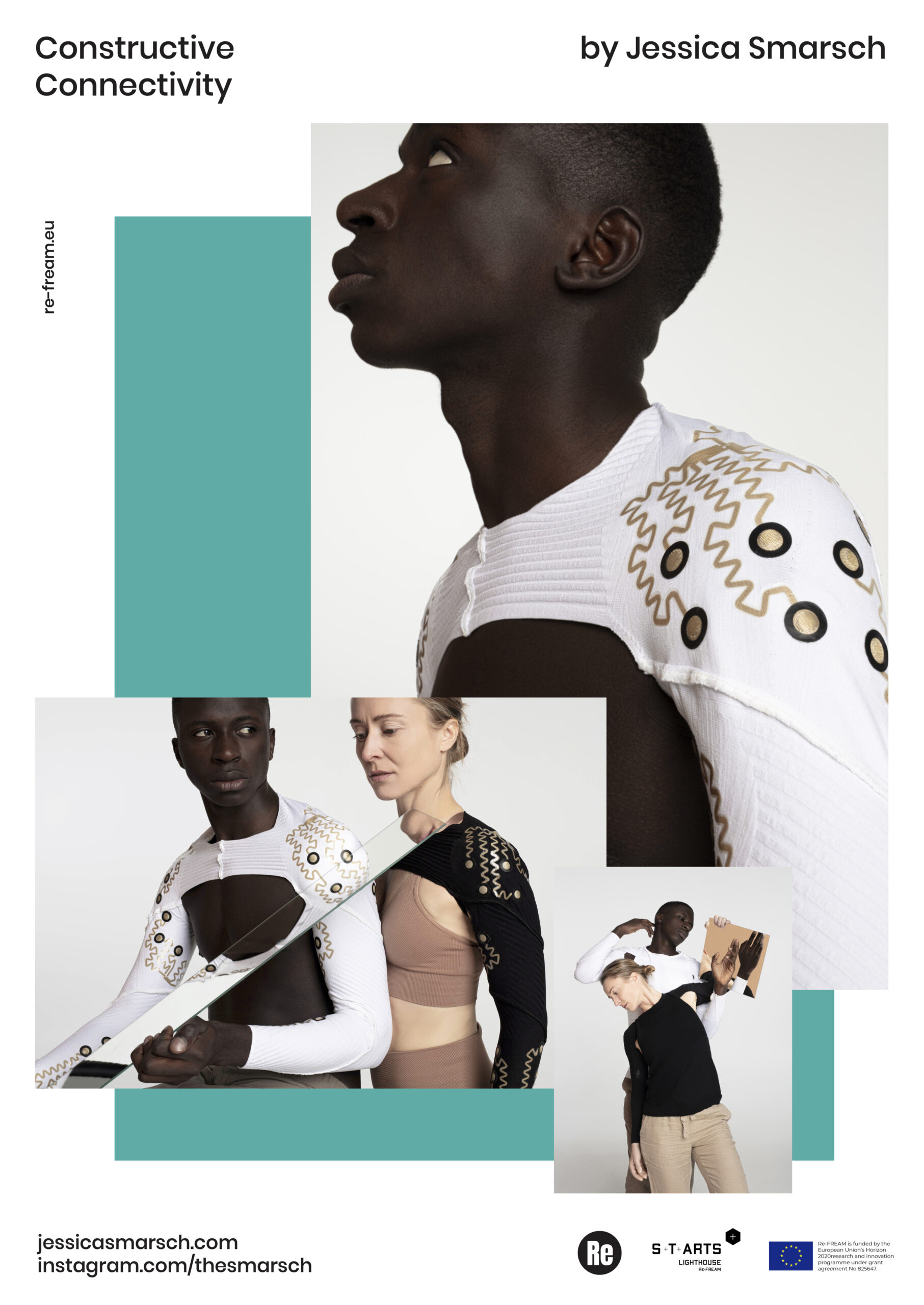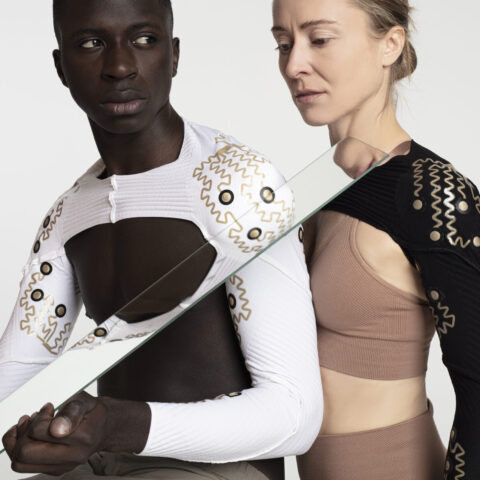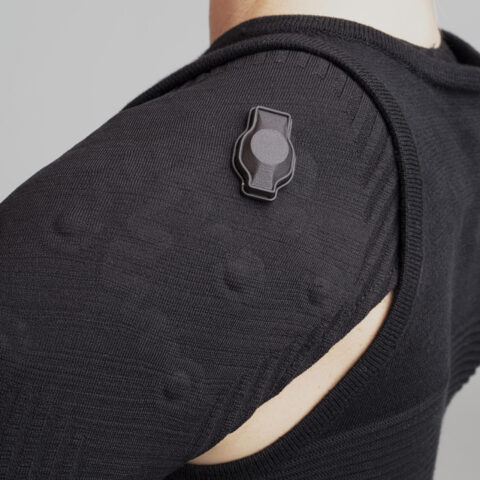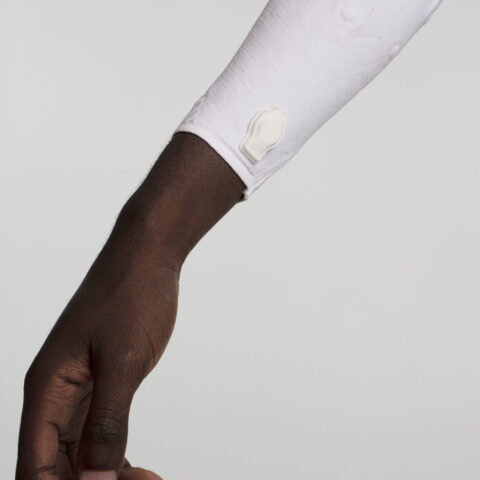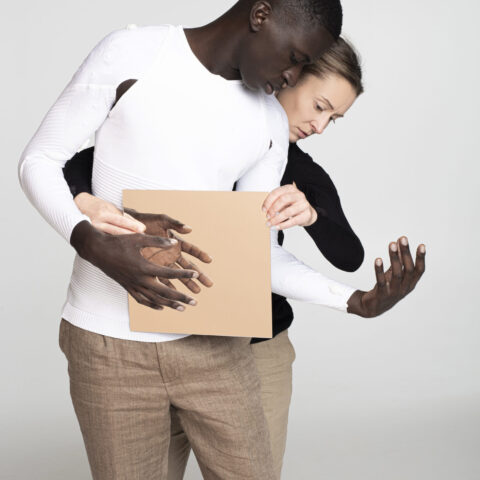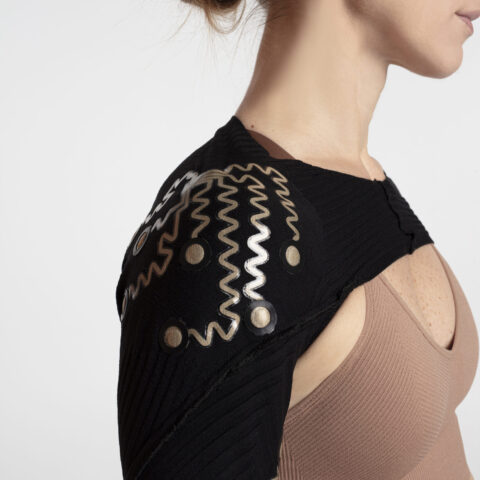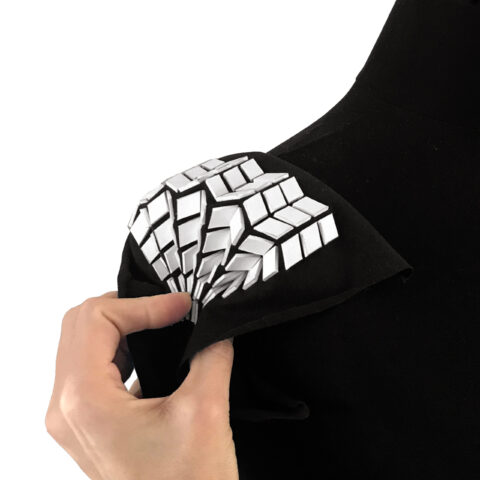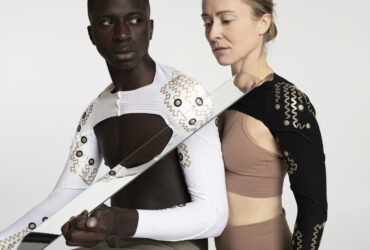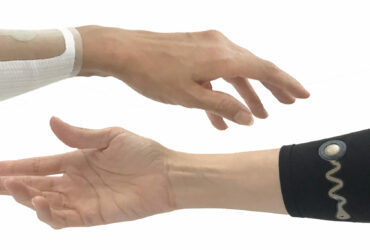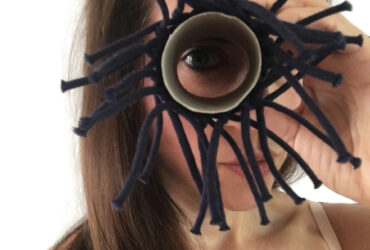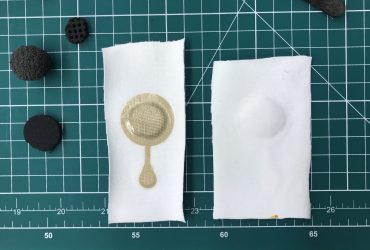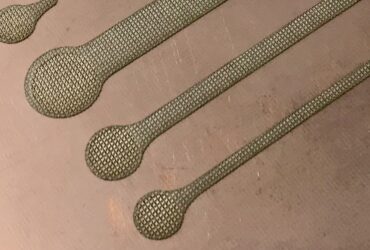The Connextyle “techstyle” sleeves Smarsch designed during her Re-FREAM collaboration reach far beyond fashion design — they function as a tool for mind-body healing. Stroke is a neural affliction that often impairs physical abilities. Smarsch’s garments are designed to improve upper body mobility for recovering stroke patients through engaging and creative exercises. Their embedded sensors connect to an app, which transforms movement data into artful designs. The visual outputs stimulate creativity in the recovery process and increase neural attention during the exercise. The additional sensory feedback and heightened neural attention help the brain to create new neural pathways. These innovative design and manufacturing processes contribute to a holistic approach to healthcare.
The knitted sleeve design adapts to a variety of lifestyles: it can be worn with its matching cotton knit shirt, or under any regular daywear. The sleeve pattern is a complex ergonomic construction, with seams that snake around the arm and follow the paths of the muscles. The design uses a combination of a biodegradable yarn with a high-stretch core, and a silver-polyamide fiber, used for its antibacterial properties. Fraunhofer’s flexible textile circuit boards (TexPCBs) sense EMG data and are laminated inside the sleeves. A detachable processing module receives the data from the TexPCBS and transmits it to an app via Bluetooth, along with movement activity. The app transforms this data into visual representations of the patients’ gestures. These meditative pattern-building exercises encourage patient movement as well as creativity and produce artful results. Adding visual feedback to the exercises helps to stimulate the creation of new neural pathways. The app also provides informative progress reports. The garment’s embedded technology aids in the feedback process, ultimately helping patients to restore confidence and well-being.
The Connextyle project illustrates the potential physical and emotional impact of beauty, turning a medical device into high-tech fashion and positioning the patient as a creator. The project’s philosophy is rooted in the Japanese philosophy and practice of Kintsugi, which sees restoration as an added value, an apt metaphor for rehabilitation.
The sleeves are designed for long-term use. The snap design of the module clip allows easy removal for recharging the module and washing the sleeves. The use of anti-bacterial yarn and the open-armpit sleeve design also translate to fewer washes. Fraunhofer IZM TexPCBs can be de-laminated by re-applying heat, creating opportunities for material separation and re-use. These features are first-steps towards more environmentally friendly e-textile products.
While designed for stroke patients, body-feedback garments could be used for a wider range of patient rehabilitation. By tracking body data, patients can milestone their progression and therapists can tailor their patients’ programs more effectively.
A patient’s health extends beyond the individual. As their independence and motivation increases, their ability to contribute meaningfully to society does, too. Hence, innovative approaches to healthcare, including new wearable tech design and manufacturing processes, can become curative for both individuals and communities.
The co-creation research performed by Jessica Smarsch and Fraunhofer IZM partner Christian Dils focused on the integration of textile-based sensors (TexPCBs) into clothing to facilitate stroke patient recovery. Technical challenges included optimizing the materials and sensor designs to obtain clear signal quality and measure EMG readings from dry electrodes. In the development process, they learned that the materials’ technical effectiveness was also highly dependent on the processing technology.
Smarsch experimented with 3D modelling for the first time in order to produce the module’s snap integration. To create a truly ergonomic sleeve pattern adapted to arm muscle structures, the last three months of the project became a collaborative remote knitwear design challenge. This involved a pattern designer in Madrid, a knitwear expert in Amsterdam, the designer in Eindhoven, and the Fraunhofer team in Berlin. The final prototypes illustrate a highly successful remote workflow.
This product development was part of a larger initiative to affect real change in stroke care. Smarsch worked with a wide range of experts in the process, and the research culminated in a 2-day Stakeholder Workshop, co-facilitated with Fraunhofer IZM partners Max Marwede and Robin Hoske. Through guided activities, participants identified and discussed important issues related to this medical device development.
The project illustrates the potential that e-textiles can have on holistic approaches to healthcare. Sensitive design that addresses a patient’s emotional experience and creative interventions that focus on achieving small goals can help inspire a patient in their difficult journey towards restored mobility. Neural effects from stroke often lead to physical impairments, clearly illustrating the fragile connection between the body and the mind. Reversing the effects of stroke must integrate a whole-body approach and focus on this precious mind-body connection. More than just wearable-tech design, the Connextyle “techstyle” sleeves are a proof of concept for empathetic design applications, illustrating the need for collaborations between artists/designers, industry and scientific research.
Smarsch’s goals are to promote holistic design approaches and apply her experience towards real-world impact: “I’m very open to sharing information about my project – the goal is not to protect the product IP, but to do meaningful work”. Instead of a traditional design career producing and selling products, she envisions careers for creatives where companies value designers’ visionary approaches and offer the necessary financial and technical support to sustain a respectable living while also translating design research into real world applications. “Being a designer today is no longer about making a product and selling it. It is about materializing a (revolutionary) vision”. Creative processes can be used to not just design products but improve society as well.
The Project
The co-creation research performed by Jessica Smarsch and Fraunhofer IZM partner Christian Dils focused on the integration of textile-based sensors (TexPCBs) into clothing for the functional purpose of gathering EMG data for stroke rehabilitation. Sensitive considerations were also made in the design of the garment to enhance the wearer’s experience with the system.
Many external partners were also involved in the research, which culminated in a 2-day Stakeholder Workshop, facilitated by Fraunhofer IZM partners Max Marwede and Robin Hoske. Through guided activities, participants identified and discussed important issues related to this medical device development. Project renamed later to Connextyle.
The Partners
Jessica Smarsch worked within the Smart Textile Hub of Re-FREAM, focused on e-textiles. Her partners were Fraunhofer IZM (Berlin), POL Studio (Madrid), The Knitwear Lab (Amsterdam) and ItoM Medical (Netherlands). Additional input was contributed by IED Madrid, Wear It Berlin, Adelante Rehabilitation Centre, Metafas B.V. and Stratasys.
The Technologies
Connextyle is a rehabilitation garment designed for measuring and stimulating muscle activity. The garment features embedded TexPCBs (textile circuit boards) which are silver-coated textiles laminated between thermoplastic material. The dry electrode designs created from this material collect and transmit muscle data to a processing module, which also registers movement. The module is attached to the garments’ exterior 3D-printed snap design. The data is transformed into creative patterns, modulated by the patient’s activity. The resulting designs activate participation, well-being, and thereby recovery. A second concept design was created using a transparent yarn for the TexPCB areas, applying the Kintsugi principle of “beautiful repair”. New research into stretchable transparent yarns would be necessary to make this second concept fully functional.
Max Marwede, Fraunhofer IZM, about the project
“Jessica’s concept is a blueprint for future cross-disciplinary research projects in the healthcare sector. Through an extensive stakeholder process and a co-research of the novel Textile Circuit Board technology from Fraunhofer IZM, Jessica was able to explore almost every aspect of her concept from technology, function, aesthetics, and user-centric design, especially supporting the patient in their dignity during rehabilitation through form and function of her garment.
She has shown that the designer must not only have a vision, but also negotiation skills to balance the interests and different perspectives of the stakeholders – in her case parties involved in the patient’s rehabilitation program.”
The Artist
Jessica Smarsch is a designer and researcher. The focus of her work over the past several years has been on pattern & repetition as it relates to behavior, well-being, and most recently stroke rehabilitation. Her fascination with pattern began with textile design, which she more clearly defined during her masters thesis research. The focus of her work has been primarily on the benefits of the process, though it has also resulted in objects, films, and interactive software. Her focus on mind-body connection has led to her current work with the stroke rehabilitation process. Smarsch works collaboratively cross-sector with science and technology to enrich the development and outcome of the work, and to better affect the intended audience.
Follow Jessica




